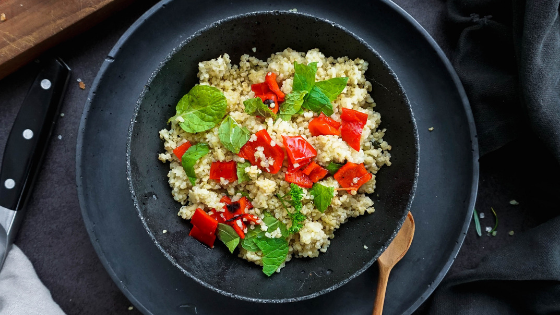4 min|Rhiannon Lockhart
Building A Balanced Diet (Without Counting Calories)
Wellness, Nutrition, HealthAchieving a Healthy Diet Without Counting Calories
In a world where we barely have downtime and stress levels are through the roof, adding another item to our “to-do” list can seem daunting. There are times when knowing our caloric intake is important (like if you are a high-performing athlete), however having a balanced diet can help with weight-management, blood sugar regulation, and overall energy. That's why I like to follow a few simple tricks to building a balanced plate!If you're looking to follow a more balanced diet, here are 4 simple steps to building your plate, without counting calories:
1. Start with vegetables
Vegetables should be the base of all of your meals. Roast them, make a salad, mix everything into a veggie stir fry, simply steam them, or cook them into a big soup. During the winter months, I usually suggest that you lightly cook your vegetables in some form to help with digestion. When you build your meal around your vegetables, it becomes easy to get in your daily intake of 8 fruits and veggies… plus more! Vegetables aren’t just a low calorie option, they are nutrient dense with a variety of vitamins and minerals, as well as fibre to help support energy, regular bowel movements and overall health.2. Add some condi-meats
You read me right, I said “condi-meat”. I saw this term a while back, and think it is a wonderful way to look at how animal protein should fit on our plates: it shouldn’t be the main event. Including a small amount (about a palm-size) of quality protein at each meal is a good way to regulate blood sugar, feel satiated and assist with long-term weight management. If you lead a vegan or vegetarian-based lifestyle, supplement this with tempeh, eggs, or another protein source (I encourage you to choose whole foods rather than packaged imitation meats).3. Choose a healthy fat
If you have learned anything from the last decade, I hope it is to not fear fat! Fats can be part of a healthy diet, especially when you choose wisely. Not only can fat help increase satiety, but it can also help promote better skin health, balance hormones, and reduce cravings. This is partly why “bulletproof coffee” took the world by storm the last few years. Try to choose plant-based sources of fat including:- Avocado and avocado oil
- Coconut milk, coconut oil
- Olive oil (do not cook with this, and only use it as a condiment)
- Nuts and nut butters
- Seeds and seed butters (my favourite is pumpkin)
- Chia and flax seeds & oils

Fats and oils you should avoid:
- Canola oil which is shown to promote chronic inflammation
- Any oil used at most restaurants, which quickly becomes carcinogenic after prolonged use in frying
- Any oil in clear, plastic containers; opt for dark glass and store it in a cool, dark place
4. Include complex carbohydrates
If we've learned anything from low-carb diets, carbohydrates aren’t exactly essential at each meal. However, adding complex carbohydrates can help increase the overall fibre content on your plate and promote better bowel movements and support detoxification. Choosing complex carbohydrates is a great way to increase fibre, and reduce cravings and hunger between meals. Here are a few of my favourites:- Sweet potato
- Beets
- Beans & legumes
- Quinoa
- Oats
- Barley
- Bulgar
Click here to book an appointment at Integrative.
Related Articles

4 min|Dr. Alex Chan
EBOO for Chronic Inflammation: A Natural Approach for Systemic Relief
Regenerative Medicine, EBOO Therapy
4 min|Dr. Alex Chan
EBOO Therapy for Autoimmune Conditions: Exploring the Potential Benefits
Autoimmune Disease, Regenerative Medicine, EBOO Therapy


